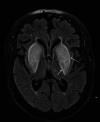Uremic Encephalopathy Presented as Stroke: The Value of Lentiform Fork Sign
- PMID: 39600546
- PMCID: PMC11590687
- DOI: 10.7759/cureus.74339
Uremic Encephalopathy Presented as Stroke: The Value of Lentiform Fork Sign
Abstract
Uremic encephalopathy (UE) is a neurological complication of renal failure characterized by cognitive dysfunction and movement abnormalities. A novel radiologic sign termed the "lentiform fork sign" has been identified in patients with UE and metabolic acidosis. This sign manifests as bilateral symmetrical hyperintensities in the basal ganglia, bordered by a hyperintense rim on magnetic resonance imaging (MRI), particularly on T2-weighted and fluid-attenuated inversion recovery (FLAIR) sequences. The basal ganglia, highly metabolically active structures, are prone to damage from metabolic derangements, toxins, and systemic conditions. We present a 56-year-old male with a history of chronic kidney disease and diabetes mellitus, maintained on hemodialysis and metformin. The patient presented with acute neurological symptoms, including slurred speech, left-sided weakness, and dysarthria. Brain MRI revealed bilateral basal ganglia hyperintensities on T2-weighted images, consistent with the lentiform fork sign. Laboratory investigations showed elevated serum urea and metabolic acidosis, suggestive of uremic encephalopathy. The patient's condition improved following dialysis, leading to partial resolution of neurological symptoms.
Keywords: basal ganglia hyperintensities; case report; lentiform fork sign; stoke; uremic encephalopathy.
Copyright © 2024, Albadr et al.
Conflict of interest statement
Human subjects: Consent for treatment and open access publication was obtained or waived by all participants in this study. Conflicts of interest: In compliance with the ICMJE uniform disclosure form, all authors declare the following: Payment/services info: All authors have declared that no financial support was received from any organization for the submitted work. Financial relationships: All authors have declared that they have no financial relationships at present or within the previous three years with any organizations that might have an interest in the submitted work. Other relationships: All authors have declared that there are no other relationships or activities that could appear to have influenced the submitted work.
Figures


References
-
- Uremic encephalopathies: clinical, biochemical, and experimental features. Mahoney CA, Arieff AI. Am J Kidney Dis. 1982;2:324–326. - PubMed
-
- KDIGO 2020 clinical practice guideline for diabetes management in chronic kidney disease. Kidney Int. 2020;98:0. - PubMed
-
- Diabetes management in chronic kidney disease: synopsis of the KDIGO 2022 clinical practice guideline update. Navaneethan SD, Zoungas S, Caramori ML, et al. Ann Intern Med. 2023;176:381–387. - PubMed
Publication types
LinkOut - more resources
Full Text Sources
